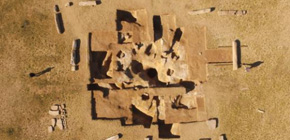
Discovery of ruins of ancient Turkic monument surrounded by 14 pillars with inscriptions
A joint excavation team from Osaka University and the Institute of History and Archaeology of the Mongolian Academy of Sciences discovered the ruins of a unique monument surrounded by 14 large stone pillars with Turkic Runic inscriptions arranged in a square on the steppe called Dongoin shiree in eastern Mongolia during their three-year (2015 ~ 2017) joint excavation. (Figure 1)
Before the investigation of the ruins began in May 2015, intellectuals involved had thought that inscriptions and ruins of Turkic royalties were only on the steppes in the western part of Ulan Bator, the capital of Mongolia (Figure 2). However, this excavation team led by Professor Takashi OSAWA at Osaka University discovered 12 new inscriptions at the site, obtaining clues for clarifying power relationships in eastern Mongolia in the Middle Ages from the contents of the inscriptions and the stone configuration at the monument.
The major feature of the monument is its structural configuration in which the stone sarcophagus at the center of the mound, where a deceased person might be placed, is surrounded by 14 stone pillars with inscriptions (Figure 3). On ever stone inscription, tamga (signs) of the ancient Turkic tribes are carved more than 100. These excavated inscriptions are some of the largest Turkic inscriptions discovered in Mongolia. Using radiocarbon dating of pieces of calcined coal, sheepskin, and horse bone excavated from the sarcophagus, it was estimated that this unique monument was built in the 8th century, during the late Second Ancient Turkic Qaghanate.
Professor Takashi OSAWA deciphered these inscriptions and found that the person who is buried and commemorated in the inscriptions assumed the position of Yabgu (viceroy), the highest ranking just behind Qaghan *, during the reign of Bilge Qaghan (716-734 AD) of the Second Turkic Qaghanate. It was also found that the Yabgu became a Tölis-Shad (Royalty of the East), a commander in chief and highest administrative officer, in eastern Mongolia during the reign of Tengri Qaghan (734-741 AD).
* Qaghan (or Khagan ) is a title of imperial rank in the Turkic and Mongolian languages equal to the status of emperor, and is someone who rules a Qaghanate or Khaganate (empire).
These findings show that the Dongoin shiree steppe, where the unique monument ruins remain, was the center of the eastern area of the ancient Turkic Qaghanate, whose location was not known from materials written in Chinese and Turkic texts.
This monument will reveal that power relationships of rulers in the east area of the Turkic Qaghanate and their territories as well as their political and military relationships with Mongolian tribes, such as the Khitan, Tatabi, and Tatar. In addition, the arrangement of these stone pillars on the plateau will also provide important information for discussing the religious ideas and world outlook of the ancient nomads.

Figure 1. Drone aerial shot of the ancient Turkish ruins on Dongoin shiree. (North at the top.) Segments of the inscriptions and sarcophagus excavated from the hole at the center of the ruins can be seen. (September 2016) (credit: Osaka University and Institute of History and Archaeology, Mongolian Academy of Science)

Figure 2. Conventional map showing places of ancient Turkic inscriptions and ruins on the Mongolian Plateau (credit: Takashi OSAWA)

Figure 3. Illustration of a ritual conducted around the monument (drawn by former director of the National Museum of Mongolian History) (September 2016) (credit: Osaka University and Institute of History and Archaeology, Mongolian Academy of Science)
Related links
To view the ruins prior to excavation (May 2013), click here . (link in Mongolian)
